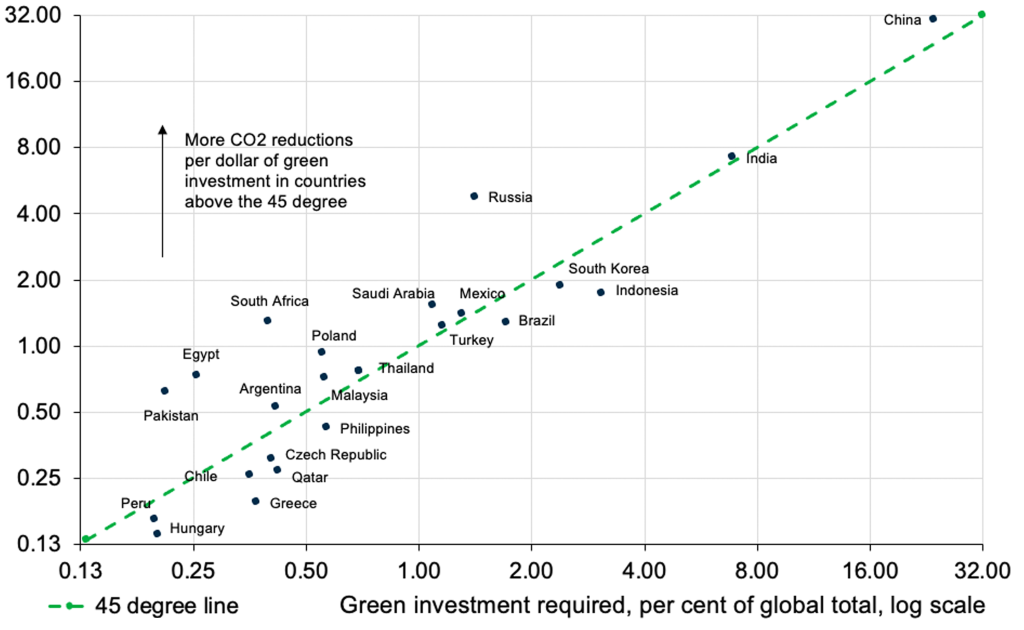Implications for investors
Excerpts from the report: An investor’s guide to net zero.
DISCOVER
Understanding the investment risks and opportunities created by what may be the largest redeployment of capital in history
Excerpts from the report: An investor’s guide to net zero.
1.The nature of around US$100 trillion worth of investment will be very different in the net zero scenario compared to business as usual – this creates opportunities and risks.
2.The firms which profit most from the transition will not necessarily be the ones making most of the green investment.
3.Mining activity is set to increase significantly as demand for metals and minerals used for transition-related technology (i.e., lithium) soars.
4.Incumbents from all sectors, but especially energy and utilities, should play a key role in making net zero a reality; but if they don’t do the green investment, new players will.

Investors can do more to ensure the funds they manage are aligned with the Paris climate goal, and that the companies in which they invest are making the investments necessary to turn these pledges into reality
Shamik Dhar
Chief Economist
.png)
Our report, An investor’s guide to net zero by 2050, shows massive capital investment in lower-carbon infrastructure is needed for the world to comply with the Paris climate goals. But there are obstacles.
* Cumulative investment between now and 2050 under business-as-usual (BAU) and net zero scenarios.
While most of the heavy lifting will be done by the private sector, policymakers have a vital role to play in overseeing the transition: setting clever and reliable policy can encourage private sector investment.”

Head of climate economics, Fathom Consulting
While most of the heavy lifting will be done by the private sector, policymakers have a vital role to play in overseeing the transition: setting clever and reliable policy can encourage private sector investment.

Head of climate economics, Fathom Consulting
For one, not everyone agrees with the capital spending estimates of what it will take to “green” the world.
It is complicated by things such as technological progress, the rate GDP growth and the fact there is no consensus on precisely what should be considered ‘green’ investment, the report’s authors say. For example, if industrial-scale lithium-ion batteries become the primary source of electricity storage, much of the gas infrastructure would be rendered useless and scrapped, resulting in a different level of investment to reach net zero than if hydrogen was part of the future energy mix and gas infrastructure could be retained and repurposed, say the report’s authors. Likewise, the report reads, the ability to use existing aircraft will depend on which low-carbon aviation technology becomes established.
|
Cumulative values between now and 2050
|
USD trillion 2020 prices |
|---|---|
|
Economy-wide investment |
396,6 $ – 597,0 $ |
|
Green investment |
61,4 $ – 166,1 $ |
|
Stranded assets |
4,2 $ – 22,4 $ |
Source: BNYM/Fathom Consulting. Date as of September 2022
Model output ranges following adjustments to capital stock to GDP ratio, depreciation rates, GDP growth rates and the clean capital share of total capital.
Source: BNYM/Fathom Consulting. Date as of September 2022
Some corporates must either absorb significant losses or will need to be compensated for these necessary losses. This is the greatest challenge in meeting the Paris climate goal. Our analysis also shows the amount of assets that are stranded rises the longer the transition gets delayed.
The sectors that need most of the investment to achieve net zero by 2050, are, it seems, at least in part, being shunned by some investors for the very same reasons.
According to the paper, around US$20 trillion of polluting assets will likely need to be scrapped or retrofitted: these are referred to in the report as ‘stranded assets’. Energy, utilities and airline sectors face some of the most significant costs in scrapping polluting assets, say the report’s authors. They purport that half of all corporate investment required for net zero by 2050 must be spent by firms in the energy and utilities sectors – even though their combined market capitalisation is just 6% of the total.
|
Sector Name
|
Investment 2020 prices, USD bn¹
|
Investment, % of total
|
Market Cap, % of total
|
PPE, USD bn²
|
Market cap to PPE ratio
|
|---|---|---|---|---|---|
|
Energy
|
3,113
|
26.6
|
2.8
|
847
|
1.2
|
|
Utilities
|
2,408
|
20.6
|
2.5
|
1,161
|
0.8
|
|
Communication services
|
705
|
6.0
|
11.2
|
828
|
5.0
|
|
Capital goods
|
655
|
5.6
|
5.9
|
193
|
11.3
|
|
Materials
|
511
|
4.4
|
2.8
|
260
|
4.0
|
|
Automobiles & components
|
478
|
4.1
|
2.0
|
184
|
4.0
|
|
Health care
|
441
|
3.8
|
12.9
|
288
|
16.5
|
|
Information technology
|
418
|
3.6
|
25.6
|
354
|
26.7
|
|
Airlines
|
418
|
3.6
|
0.3
|
135
|
0.8
|
|
Retailing
|
390
|
3.3
|
7.4
|
367
|
7.5
|
|
Food & staples retailing
|
327
|
2.8
|
1.8
|
210
|
3.2
|
|
Air freight & logistics
|
302
|
2.6
|
0.7
|
90
|
3.0
|
|
Financials
|
247
|
2.1
|
11.6
|
378
|
11.3
|
|
Real estate
|
229
|
2.0
|
2.4
|
456
|
2.0
|
|
Road & rail
|
226
|
1.9
|
1.0
|
130
|
2.7
|
|
Hotels, resorts & cruise lines
|
212
|
1.8
|
0.7
|
88
|
2.9
|
|
Food products
|
172
|
1.5
|
1.1
|
58
|
6.9
|
|
Beverages
|
133
|
1.1
|
1.5
|
40
|
13.9
|
|
Household & personal products
|
123
|
1.1
|
1.5
|
42
|
13.4
|
|
Restaurants
|
64
|
0.5
|
1.1
|
67
|
6.2
|
|
Consumer durables & apparel
|
54
|
0.5
|
1.1
|
26
|
16.2
|
|
Commercial & professional services
|
47
|
0.4
|
0.9
|
35
|
9.6
|
|
Tobacco
|
24
|
0.2
|
0.7
|
8
|
29.7
|
|
Casinos & gaming
|
21
|
0.2
|
0.3
|
73
|
1.5
|
|
Total
|
11,719
|
|
|
|
|
¹ Total green investment required by each S&P 500 sector by 2050, net zero
scenario. Constant, 2021 prices
² Property, plant and equipment.
The report’s authors have created a new and unique methodology and used it to score 24 stock market sectors on their transition risks. How quickly decarbonization is likely to happen in each sector and how problematic, from an economic point of view, that is likely to be.
|
Sector Name
|
Overall transition risk
|
“Carbon tax 1”
|
“Carbon tax 2”
|
Carbon tax + transition speed
|
Transition speed 1
|
Transition speed 2
|
Stranded assets 1
|
Stranded assets 2
|
Stranded assets 3
|
Disclosure
|
|---|---|---|---|---|---|---|---|---|---|---|
|
Utilities
|
2,0
|
3,6
|
2,3
|
4,2
|
3,4
|
3,2
|
0,5
|
1,9
|
0,0
|
-0,8
|
|
Energy
|
1,6
|
0,8
|
3,3
|
4,5
|
0,2
|
-0,3
|
2,2
|
1,0
|
2,0
|
0,6
|
|
Airlines
|
1,2
|
2,5
|
1,1
|
0,1
|
-0,8
|
-0,3
|
1,9
|
1,9
|
4,0
|
0,1
|
|
Road & rail
|
0,3
|
0,0
|
-0,4
|
-0,1
|
-0,2
|
-0,3
|
1,3
|
2,9
|
-0,2
|
-0,3
|
|
Real estate
|
0,2
|
-0,5
|
-0,6
|
-0,4
|
2,4
|
3,2
|
-1,1
|
-0,1
|
-0,3
|
-0,4
|
|
Hotels, resorts & cruise Lines
|
0,1
|
0,0
|
0,1
|
0,2
|
-0,6
|
-0,3
|
0,4
|
-0,1
|
0,7
|
0,6
|
|
Materials
|
0,0
|
0,2
|
0,1
|
0,4
|
-0,4
|
-0,3
|
0,2
|
0,0
|
-0,2
|
-0,4
|
|
Food products
|
0,0
|
-0,4
|
0,0
|
0,0
|
-0,3
|
-0,3
|
0,9
|
0,2
|
-0,2
|
-0,3
|
|
Automobiles & components
|
-0,1
|
-0,4
|
0,8
|
1,3
|
-0,5
|
-0,3
|
-0,3
|
-0,6
|
-0,2
|
-0,3
|
|
Capital goods
|
-0,1
|
-0,4
|
0,0
|
0,0
|
-0,8
|
-0,3
|
0,4
|
-0,2
|
-0,3
|
0,8
|
|
Casinos & gaming
|
-0,1
|
-0,4
|
-0,7
|
-0,5
|
0,8
|
-0,3
|
-1,2
|
-0,5
|
-0,3
|
2,1
|
|
Air freight & logistics
|
-0,1
|
0,1
|
0,2
|
-0,1
|
-0,8
|
-0,3
|
1,0
|
0,5
|
-0,3
|
-1,5
|
|
Consumer durables & apparel
|
-0,2
|
-0,5
|
-0,5
|
-0,3
|
-0,5
|
-0,3
|
-0,5
|
-0,7
|
-0,4
|
1,7
|
|
Food & staples retailing
|
-0,3
|
-0,3
|
-0,6
|
-0,4
|
-0,4
|
-0,3
|
0,1
|
-0,1
|
-0,3
|
-0,3
|
|
Restaurants
|
-0,3
|
-0,4
|
0,0
|
0,1
|
-0,7
|
-0,3
|
-0,5
|
-0,3
|
-0,4
|
-0,1
|
|
Beverages
|
-0,3
|
-0,4
|
-0,2
|
0,0
|
-0,5
|
-0,3
|
0,2
|
-0,2
|
-0,4
|
-1,1
|
|
Communication services
|
-0,3
|
-0,5
|
-0,7
|
-0,5
|
0,6
|
-0,3
|
-1,3
|
-1,0
|
-0,4
|
1,0
|
|
Retailing
|
-0,4
|
-0,4
|
-0,6
|
-0,4
|
-0,3
|
-0,3
|
-0,8
|
-0,6
|
-0,4
|
0,5
|
|
Health care
|
-0,4
|
-0,5
|
-0,7
|
-0,5
|
-0,2
|
-0,3
|
-0,7
|
-0,7
|
-0,4
|
0,6
|
|
Household & personal products
|
-0,4
|
-0,4
|
-0,5
|
-0,4
|
-0,2
|
-0,3
|
0,5
|
-0,1
|
-0,4
|
-1,7
|
|
Tobacco
|
-0,4
|
-0,4
|
-0,4
|
-0,2
|
-0,1
|
-0,3
|
0,3
|
-0,1
|
-0,4
|
-2,2
|
|
Commercial & professional Services
|
-0,4
|
-0,5
|
-0,7
|
-0,5
|
-0,3
|
-0,3
|
-0,8
|
-0,9
|
-0,4
|
0,6
|
|
Financials
|
-0,4
|
-0,5
|
-0,7
|
-0,5
|
0,3
|
-0,3
|
-1,2
|
-1,0
|
-0,4
|
0,4
|
|
Information technology
|
-0,6
|
-0,5
|
-0,7
|
-0,5
|
-0,4
|
-0,3
|
-1,3
|
-1,1
|
-0,4
|
0,2
|
Note: all variables and ratios have been calculated and adjusted so that higher
scores reflect more exposure to transition risk.
Green = relatively low transition risk; red = relatively high transition risk.
Source: BNYM / Fathom Consulting. Date as of September 2022
There are a few reasons for this. First, the country is large and already accounts for more than 15% of global GDP. Second, it is expected to grow faster than most economies between now and 2050 and more investment, including green investment, will be needed to support this growth. Third, a higher-than-average share of electricity production in China comes from fossil fuels and the country also has an above-average CO2 intensity of GDP.
1.
Each dollar of green investment in an EM may achieve more decarbonization than the equivalent amount spent in an advanced economy.
2. India, China, South Korea and Indonesia are expected to grow faster than the global average and currently use a lot of coal for electricity generation. Consequently, they require a larger share of green investment than their current share of global GDP.
3.
Around a third of investment will need to be spent in the US and EU combined.
Source: Source: Penn World Table / Refinitiv Datastream / BNYM / Fathom
Consultiong
*In net zero by 2050 scenario
Source: BNYM / Fathom Consulting. Date as of September 2022,

Source: Penn World Table / Refinitiv Datastream / BNYM / Fathom Consulting. Date as of September 2022
They may do a lot of the heavy lifting but much of it will probably need to be done by households and governments, by, for example, purchasing electric cars, buying new, green heating systems and insulating their homes and buildings. Funding for this should come from a range of sources including earnings, tax revenues and bank loans.
Some of the low-hanging fruit has not yet been picked. One example is the switch from coal-powered generation to renewables: financing this switch can provide a wide-ranging impact, including cost savings for households on their electricity bills, leading to wider social benefits. Such investment doesn’t just make sense for the climate, it makes business sense too.

Chief Economist, BNYM
View our team biographies to learn more.

Chief Economist BNY Mellon Investment Management
Shamik Dhar has 36 years’ experience as an economist. Starting his career in H.M. Treasury as an economist assistant in the mid-1980s, he moved to Oxford Forecasting and then spent most of the 1990s as a senior economist in the Bank of England, where he worked on the UK economic forecast in the early days of inflation targeting and on monetary policy analysis in the early days of the Monetary Policy Committee.
Shamik moved to Aviva Investors (formerly Morley Fund Management) in 2000 and spent the next 14 years in the City of London, ending up as Head of Investment Strategy. Un 2014 he became the chief economist at the Foreign and Commonwealth Office in a period of rapid geopolitical and economic change, advising ministers and senior officials on the economics of Brexit. Shamik joined BNY Mellon Investment Management as global chief economist in October 2018.
Shamik has a degree in Philosophy, Politics and Economics from Oxford University and a master’s in economics from Queen Mary College, University of London. He also spend a year as a visiting scholar at the University of Pennsylvania in the mid-1990s.

Lale is a joint portfolio manager on the Future Legacy team. Prior to joining Newton, Lale worked at BNY Mellon Investment Management for over a decade as a senior investment strategist where she was one of the firm’s leading voices on market analysis, multi-asset investment strategy and macroeconomic outlook supporting all client segments. She brings to Newton the depth of global macroeconomic knowledge and cross-asset perspective the multi-asset solutions require. Lale is also a regular on-the-record source and live-broadcast commentator, delivering market views to external audiences through a variety of media outlets.
Lale earned her Master of Arts degree in economics from Yale University, and Master of Science degree in finance (MSIA) from Carnegie Mellon University’s Tepper School of Business. Lale was a Teaching Fellow at Yale University and was awarded the Yale University Department of Economics.

Jake Jolly is a Senior Investment Strategist at BNY Mellon Investment Management. In this role, he is a primary contact for the firm’s largest and most complex clients, providing ongoing updates on the market outlook, investment philosophy, process, and performance across asset classes. He produces rigorously researched market commentary and investment content to shape investment strategy decisions. Jake collaborates with portfolio managers and researchers across BNY Mellon Investment Management’s investment firms to provide a vital link between investment, product, and distribution teams.
Prior to joining BNY Mellon Investment Management in 2021, Jake was a Portfolio Manager at systematic quant manager Dimensional Fund Advisors (DFA) for more than four years. At DFA, he managed the firm’s flagship $16B US Small Cap equity fund, among other factor-based strategies. Before DFA, Jake worked as an emerging markets economist at IHS Markit (formerly IHS Global Insight).
Originally from Northern California, Jake received his B.A. degree in Economics and International Studies from the University of California San Diego (UCSD). He is also a graduate of Brandeis University, where he earned an M.A. degree in International Economics and Finance, and from Carnegie Mellon University’s Tepper School of Business, where he earned his MBA. At Carnegie Mellon, Jake was awarded the distinction of being the graduating MBA with the highest academic achievement in Finance. Jake Jolly is CFA® charterholder.

Sonia Meskin is the US Macro Head in the NY office. Previously, she held roles with the International Monetary Fund, Standard Chartered Bank and the Federal Reserve Bank of New York. In these roles, Sonia held chief responsibility for the analysis of macroeconomic and market developments for external clients as well as internal senior management and policy stakeholders. Sonia received her undergraduate degree from the University of Pennsylvania and her Masters degree from the London School of Economics.

Aninda Mitra is a Vice-President and the Head of Asia Macroeconomics and Investment Strategy at BNY Mellon Investment Management Singapore Pte Ltd. He is based in Singapore and reports directly to the Global Chief Economist for BNY Mellon Investment Management. He is the primary contact for the firm’s clients, prospects and consultants in the APAC region for providing ongoing updates and insights about the economic, market and investment outlook on China and other major Asian economies, as well as implications for asset classes.
Mr. Mitra has twenty five years of experience in the financial services industry. Prior to joining BNY Mellon IM’s Global Economics and Investment Analysis team, he was a Senior Sovereign Analyst at Mellon Investment Corporation (formerly Standish Mellon) for more than seven years where he was responsible for fixed-income macro research for Asian and Mid-East markets. Before that he was employed on the sell-side as Head of Southeast Asia Economics at ANZ bank, and, prior to that as a Senior Sovereign Analyst at Moody’s where he managed the ratings of a diverse portfolio of APAC sovereign credits. He began his career, in the U.S., as a Country and Banking Risk Analyst at Wells Fargo. Aninda holds an M.A. Economics from, and was a Bryan Fellow at, the University of North Carolina at Greensboro and a B.S. Economics (Magna Cum Laude) from Bridgewater College.

Sebastian Vismara is a Financial Economist in the Global Investment Strategy team at BNY Mellon Investment Management. His responsibilities include conducting analysis on the global economy, financial markets and investment implications.
Prior to this role, Sebastian spent 5 years at the Bank of England working on global macroeconomic analysis and financial market research. In his last role he provided macro financial research support for Governor Carney's international meeting engagements.
A native of Italy, Sebastian has a two-year Masters in Management with a concentration in Finance from the London School of Economics and an undergraduate degree in International Relations with a concentration in Economics from the University of Florence in Italy.
The conclusions and views expressed in this paper are derived from that research and are the opinion of the authors and do not constitute advice. All charts and data tables are provided for illustrative purposes only and are not indicative of the past or future performance of any BNY Mellon product.
FATHOM AND BNY MELLON INVESTMENT MANAGEMENT PARTNERSHIP
Since 2019, Fathom Consulting has provided bespoke macroeconomic modelling and scenario analysis for BNY Mellon IM’s quarterly economic and investment
outlook publication, Vantage Point.
Quarterly meetings are held to decide the key questions that will inform developments over the forecast horizon so that Fathom can conduct detailed scenario analysis that is theoretically founded, empirically driven and consistent with BNY Mellon IM’s house views. This helps to inform stakeholders of the outlook for the economy and markets, as well as the risks.
Fathom also engages in other bespoke projects for BNY Mellon IM, such as the work and analysis involved in the production of this research. BNY Mellon IM hired Fathom Consulting to provide expertise on the economics of climate change and undertake certain elements of this project. The final output, presented in this report, reflects the efforts of both parties.
The modelling framework and report conclusions were developed in collaboration, while Fathom’s proprietary climate data and tools were used to develop the sectoral risk framework presented in this report.
1This was an American initiative enacted in 1948 to provide foreign aid to Western Europe
For Professional Investors and Institutional Investors only. Not for further distribution.
This material should not be considered as investment advice or a recommendation of any investment manager or account arrangement. Any statements and opinions expressed are as at the date of publication, are subject to change as economic and market conditions dictate, and do not necessarily represent the views of BNY Mellon or any of its affiliates. The information has been provided as a general market commentary only and does not constitute legal, tax, accounting, other professional counsel or investment advice, is not predictive of future performance, and should not be construed as an offer to sell or a solicitation to buy any security or make an offer where otherwise unlawful.
The information has been provided without taking into account the investment objective, financial situation or needs of any particular person. BNY Mellon and its affiliates are not responsible for any subsequent investment advice given based on the information supplied. This is not investment research or a research recommendation for regulatory purposes as it does not constitute substantive research or analysis. To the extent that these materials contain statements about future performance, such statements are forward looking and are subject to a number of risks and uncertainties.
Information and opinions presented have been obtained or derived from sources which BNY Mellon believed to be reliable, but BNY Mellon makes no representation to its accuracy and completeness. BNY Mellon accepts no liability for loss arising from use of this material. All investments involve risk including loss of principal. Not for distribution to, or use by, any person or entity in any jurisdiction or country in which such distribution or use would be contrary to local law or regulation. This information may not be distributed or used for the purpose of offers or solicitations in any jurisdiction or in any circumstances in which such offers or solicitations are unlawful or not authorized, or where there would be, by virtue of such distribution, new or additional registration requirements. Persons into whose possession this information comes are required to inform themselves about and to observe any restrictions that apply to the distribution of this information in their jurisdiction.
Issuing entities: This material is only for distribution in those countries and to those recipients listed, subject to the noted conditions and limitations: Hong Kong: BNY Mellon Investment Management Hong Kong Limited. Regulated by the Hong Kong Securities and Futures Commission. Singapore: BNY Mellon Investment Management Singapore Pte. Limited Co. Reg. 201230427E. Regulated by the Monetary Authority of Singapore.
No part of this material may be reproduced in any form, or referred to in any other publication, without express written permission. All information contained herein is proprietary and is protected under copyright law. MC273-30-01-2024 (6M)
